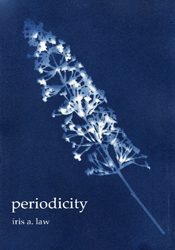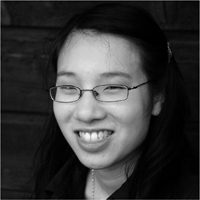
Iris A. Law’s fearless debut work, Periodicity, operates through a unique structural conceit that lushly unfolds across the arc of the chapbook: each poem takes as its subject matter a woman who was intimately connected with the world of science. Law’s diverse choice of female subjects hail from many nations and cultures, ranging from the Chinese American nuclear physicist, Chien-Shiung Wu; to the well-known French-Polish chemist and physicist Marie Curie and her two daughters, Irène and Eve; to Jane Colden, a visionary American botanist who was born in the 18th century.
In many cases, Law boldly employs dramatic monologues in order to imaginatively access the minds and the perspectives of these pioneering women. In “Rachel Carson,” for instance, she chillingly conveys the sense of environmental dread that the titular activist observes upon waking: “The square of my window grows red/ and I open the curtains to let the light in” (3). Law is never didactic in her lyric appropriations, letting the horror of particular moments emerge inconspicuously. In the conclusion to “Rachel Carson,” when she writes that, “Somewhere, a woman rises / to weep over a bowl of broken eggs,” (3) the lines recall the incredible damage done to robins, eagles, species of birds whose continued existence became imperiled by the use of the pesticide DDT. In “Barbara McClintock,” Law again makes effective use of the dramatic monologue by juxtaposing the dynamics of scientific discovery against the daily physical challenges faced by McClintock as she works: “It’s cold in the lab. My breath traces patterns / on the windows. Frost feathers yesterday’s coffee. / The whirr of the centrifuge keeps me in place” (12). Law’s poem “traces” the single-minded and almost obsessive impulse that drives the scientist in her various quests for knowledge, even as she finds her struggles with the often-agonizing process of laboratory research reflected in environmental conditions as pedestrian as the weather. McClintock will, of course, famously determine the dynamics of gene expression, though her findings will initially encounter much hostility from her peers. The weather thus seems to function in a metaphorical capacity, foreshadowing the chilly response that first greets her work, though it will eventually become so widely accepted and celebrated that she will be awarded the Nobel Prize in 1983.
Other poems in the volume are more elliptical in their approach, refracting the world of science through female figures who may have been overshadowed by their male counterparts. In “Finchsong,” for instance, Law reorients our gaze to Emma Darwin in a sonnet that explores scientific discovery through the lens of domesticity. This poem places Emma’s piano playing in parallel with Charles’s work as a naturalist in order to forcefully reveal how she had dutifully “kept house,” (5) despite being problematically sequestered from the intellectual life of her husband.
 Though many of the poems operate with a realist impulse, Law occasionally breaks from this approach, especially as seen in “The Voice Particulate,” which contains the subtitle, “the voice of Sally Ride, dispersed in space,” and presents us with an elegiac, intergalactic lyric: “I am debris, / composed of (mostly): superterranean / lightness, atoms inordinate, dust / of orbital radiance” (21). Located toward the chapbook’s conclusion, this poem certainly pushes the bounds of previous poems by conjuring a perspective situated in a kind of cosmic afterlife.
Though many of the poems operate with a realist impulse, Law occasionally breaks from this approach, especially as seen in “The Voice Particulate,” which contains the subtitle, “the voice of Sally Ride, dispersed in space,” and presents us with an elegiac, intergalactic lyric: “I am debris, / composed of (mostly): superterranean / lightness, atoms inordinate, dust / of orbital radiance” (21). Located toward the chapbook’s conclusion, this poem certainly pushes the bounds of previous poems by conjuring a perspective situated in a kind of cosmic afterlife.
The last poem, “Slant,” is dedicated to Chien-Shiung Wu. Evoking Wu’s work as a nuclear physicist, the speaker reminds us that “Matter collects / its property to itself in asymmetric heaps” (22). As uneven as such “heaps” of “matter” might literally be, this line also attends to a more figurative impulse, in that it reminds us of the challenge the poet herself faces in constructing these portraits. As the speaker goes on to note, “We do not mirror one another. Rather, we resist replication, shaping our stories / stubbornly against our chosen vectors: one arm, one eye, / a single plotted quadrant into which we arrange battered folding chairs and settle in to watch the sun / slide liquidly into the diamond-speckled dark” (22). Thus, this scientific consideration of matter also operates as a way to consider the chapbook’s difficult project: to articulate each woman’s life with a kind of complexity, such that their various perspectives can never be viewed only as reductive “replications” of one another. Law’s poems take up this challenge and exude what we might call fractal variations, arcing out from one thematic foundation and in this process furiously blooms.




